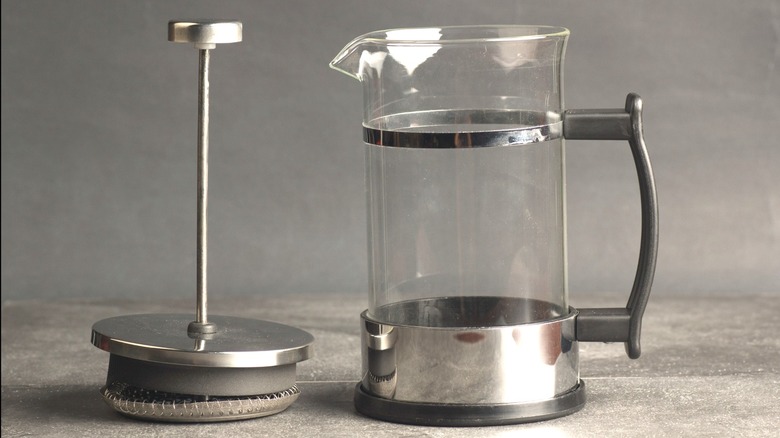Can You Froth Milk In A French Press?
Don't have a special frother to make foamy milk for your morning coffees? No problem: You don't always need a dedicated tool to get a job done. Frothing is essentially aerating milk till its consistency becomes thick, creamy, and luscious — and there are plenty of ways to give it this texture without a milk frother, or the steam wand of an espresso machine.
One appliance that can froth milk fabulously is a French press (which is not the same as an Aeropress). All you have to do is pour milk into it, close its lid tightly, and then lower and raise the plunger rapidly until the milk's volume has increased by at least half. The entire process takes about 15 seconds, meaning you'll have velvety frothed milk in less than a minute.
Let the milk rest for a minute so that the foam settles, and then tap the base of the French press gently against a hard surface and give it a quick swirl. This will break up any large bubbles that may be floating about in the milk, and give it the homogenous, silky consistency that you'd get from a steam wand. You can then pour the foamy milk into your coffees, teas, and even hot cocoas. However, don't expect to make any latte art with it — that requires precision, control, and delicately-textured milk that only steam wands offer. It's likely not a tip that a barista would approve of for making beautiful latte art.
Tips to make the best frothed milk in a French press
The most important part about frothing milk in a French press — or in any appliance, for that matter — is to consider the type of milk that you're using. Low fat and nonfat milks froth much better than full fat versions; think skim or reduced-fat milks like 2%. These usually contain more protein that can create more stable foam. On the flip side, plant-based milks lack enough protein, so they aren't the best in this scenario, either. However, if you must use one, consider opting for a product labeled "barista-style" or "barista blend," which is meant specifically for frothing.
Once you've chosen the type of milk, consider its temperature. Use warm rather than cold milk when you can, as the latter doesn't hold its foam as well. You'll also want to warm the milk to the right temperature before foaming, which is around 140 to 155 degrees Fahrenheit. Be careful not to boil it, though, as scalding hot milk doesn't froth well, either.
Make sure that there is enough milk in the French press so that the filter of the plunger fully submerges into the liquid. However, don't fill it to the brim — the milk's volume will increase as it aerates, so leave enough empty space for that. Hold the lid of the French press tightly before you get started — you don't want the milk splattering all over your walls when you push that plunger down. And finally, don't forget to clean the French press after!


